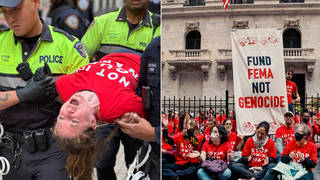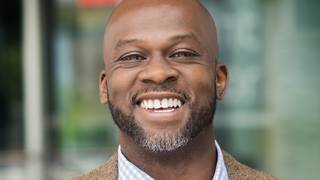
Guests
- Thea Gardellinone of the founding members of No Dal Molin, the movement against the Vicenza base.
- Stephanie WestbrookAmerican citizen living in Rome, member of U.S. Citizens for Peace and Justice in Italy.
One of the largest protests against the U.S. military this year wasn’t where you’d normally expect it. In February, more than 100,000 people marched against a plan to double the size of a U.S. base in the northern Italian city of Vicenza. A group of women leading the protests have traveled from Italy to bring their case directly to Capitol Hill. [includes rush transcript]
Transcript
AMY GOODMAN: One of the largest protests against the U.S. military this year wasn’t where you’d normally expect it. In February, more than 100,000 people marched against a plan to double the size of a U.S. base in the northern Italian city of Vicenza. Over 2,700 U.S. forces are already based there. Critics of the plan say the base will be used as a staging post for the U.S. military to attack Iraq and Afghanistan. Opposition grew so high it helped bring the brief collapse of the government of Italian Prime Minister Romano Prodi within days of the protest.
The protests against the Vicenza base are known in Italy as No Dal Molin. They’ve been led mostly by women, who have collected thousands of signatures, organized meetings and raised awareness to turn a local cause into a national movement. This week, a group of these women have traveled from Italy to bring their case to Capitol Hill.
Two of the delegation’s members join me from Washington, D.C. Thea Gardellin is one of the founding members of the movement against the Vicenza base. She’s here with Stephanie Westbrook. Stephanie is an American citizen living in Rome, a member of the U.S. Citizens for Peace and Justice in Italy.
Well, Thea, talk about Vicenza and this base. How did you get involved with this issue?
THEA GARDELLIN: Well, it started more or less a year ago. As a matter of fact, the Italian government had already been taking position, together with the American government, concerning this base more than three years ago. The population of Vicenza gradually became informed about a year ago. The people, people who run the normal lives, housewives, etc., just decided that it was something that could not be done to Vicenza and to the Vicenza citizens, considering that Vicenza is a historical UNESCO Heritage List site. It is rich in historical buildings by the 1500 architect of Vicenza, Andrea Palladio. And this new military base, it would be a new — the fourth base in the Vicenza area — would distance from the center, the heart of Vicenza — that is, the Basilica Palladiana — if I can show you a picture — not even one mile from the center of town. This is the historical Basilica Palladiana, where I have my finger over here. And what you see here in the background would be the future Dal Molin military base. As you can see from the picture, it’s one of the rare large green areas in the center of town, and the citizens of Vicenza believe that it could be used in a more proficuous way for the people and not for the military.
AMY GOODMAN: So the base is there, and they want to expand it. What kind of dialogue has there been, Thea, and what kind of protests?
THEA GARDELLIN: Well, the base is — there is no base here on the picture I showed you yet. There is no base at Dal Molin. Currently there’s a civil airport. There’s the Camp Ederle base, which also lies in the center of Vicenza, and there’s the base of Fontega — not base, it’s a military installation at Fontega and a military installation of Longare. And the impact on the people would be extremely strong, first of all, because it’s a base that would be — this new base would be approximately five kilometers long. That’s about almost, I’d say, three miles long. And you can imagine there’s all the houses right directly built on — they would be built directly on the borders of the base. You can imagine what it would be for the people living there, directly confining with the base, even though the initial projects presented did not include the housing units of the civilians. I mean, it was just the base. It seemed as if all around there was nothing, there was no city of Vicenza, there was no Palladio villas, there was no people living there. It just seemed that it would be a base in the middle of nowhere, whereas, as you can see from the picture I just showed you, this does not correspond to truth.
AMY GOODMAN: Stephanie Westbrook, you are an American citizen living in Rome. How did you get involved with this issue in Vicenza?
STEPHANIE WESTBROOK: Yes, we have been in contact with them for about the past six months. We have participated — both our group in Rome, as well as U.S. citizens from Florence — in the two national demonstrations, one in December and one in February, because we felt our voice was something needed. Any time there’s a demonstration against a U.S. military base in Italy, there are accusations of anti-Americanism, so we knew our voice was something important to be there. So we have participated in the demonstrations and have come here to help spread the word in the United States on the impact of this base. In fact, we’ve got a petition now on the CODEPINK website, codepinkalert.org, where people can sign this petition to send a message to the chairs of the Armed Services Committees, to stand in solidarity with the Italian people, the people of Vicenza, saying that they don’t want this military base and that we want to maintain ties and exchanges with Italy between the United States and Italy, but we want them to be more on a cultural basis. We don’t want them to be strictly on a military basis.
AMY GOODMAN: What are your plans, Thea Gardellin, right now coming to the United States? You’re not far right now from Capitol Hill in Washington, D.C.
THEA GARDELLIN: Well, obviously, the movement has taken more and more space, if we can say this, in Italy from the few people that started it right at the beginning almost a year ago. We have reached practically the entire nation, as well as many European countries, because the big demonstration of February 17 brought over 200,000 people to Vicenza. If you consider that Vicenza has approximately 100,000 inhabitants, you can imagine how Vicenza was that day during the demonstration.
Our intention here in Washington is to, first of all, invite the American people to be aware of what is happening to Italy, because many people will be asking themselves: Why another base in Italy? Why in Vicenza? And this is what we want. We want the American people to be aware of this, and we count on solidarity from the American people. Just like in Italy we have counted on the energy and on the solidarity of all the people, the women, the elders, even the entire families, who came to these demonstrations to say no to this base, we count on the same thing happening here in the United States — that is, letters of protest, phone calls of protest saying that you do not agree with this decision, that you do not want the base in Italy, that you want the Vicenza UNESCO World Heritage List sites to be protected from this project that they have in mind, from this war project that they have in mind. So this is the first reason why we decided to come, why a delegation decided to come to Washington, not only in representation of the entire city of Vicenza, but in representation of those more than 200,000 people that did come to Vicenza to say no to this new project.
AMY GOODMAN: Stephanie Westbrook, as an American citizen living in Italy, have you spoken with U.S. soldiers who are deploying from Italy to Iraq or Afghanistan?
STEPHANIE WESTBROOK: I have spoken with a few while I was in Vicenza. For the most part, of course, they’re not terribly open about their feelings. They do realize that there is a great deal of opposition by the people of Vicenza, and they also realize that it’s nothing against them, the few that I’ve spoken with. The people in Vicenza have learned what it means to live with soldiers deploying for war. They see the soldiers out training in the early morning around the streets, while they’re taking their children to school. So they have learned what it feels like to live with soldiers going off to war.
AMY GOODMAN: According to Chalmers Johnson, there are over 700 U.S. bases around the world. I wanted to ask Thea Gardellin, finally, if you were a part of the international organizing in March. The inaugural International Conference for the Abolition of Foreign Military Bases was held in Ecuador. Are you organizing outside of Italy now?
THEA GARDELLIN: Well, organizing outside of Italy — we have a lot of contacts with the confining countries in Italy. We have a lot of press contacts outside of Italy. We are — I mean, this is one of our first journeys outside of Italy. Obviously, we’ll be in Prague at the end of this week. We’ve been traveling throughout of Italy since a year now, contacting all other movements like ours and organizing something that in Italian is called patto di mutuo soccorso, which would be more like an agreement of mutual solidarity, that is that all the peace movements, pacifist movements within Italy unite and help each other constantly. Whereas if they have to come to Vicenza, they come to Vicenza; if we have to go to Sigonella, we go to Sigonella. And the same thing we’re trying to build throughout Europe and also throughout the entire world.
AMY GOODMAN: We’re going to have to leave it there. Thea Gardellin, thank you for being with us, Italian member of the group No Dal Molin, as well as Stephanie Westbrook.












Media Options